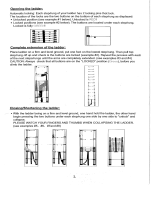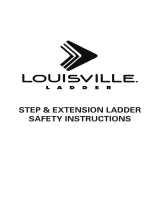
Table of Contents
Table des matières
Tabla de contenido
5
English
Introduction - LITTLE GIANT
®
Ladder Basics ...............................................................................6
Operating and Adjusting the Ladder..............................................................................................7
The Hinges ............................................................................................................................7
The Outer Ladder Locks........................................................................................................ 8
General Operating Safety Tips .............................................................................................. 9
Stepladder Mode Instructions.............................................................................................. 10
Staircase Mode Instructions................................................................................................10
Straight Ladder Mode Instructions ...................................................................................... 11
90° Mode Instructions.......................................................................................................... 12
Scaffolding Trestles Instructions.......................................................................................... 12
TIP & GLIDE™ Wheel Instructions .....................................................................................14
AIRDECK
®
Workstation Instructions....................................................................................15
COMFORT STEP™ Platform Instructions........................................................................... 16
RATCHET™ Leveler Instructions........................................................................................16
Ladder Maintenance Instructions ................................................................................................17
Little Giant Warranty.................................................................................................................... 19
Standards Compliance and Certifications ...................................................................................19
Preoperational Inspection Checklist ............................................................................................ 21
Français
Introduction - Éléments de base de l’échelle LITTLE GIANT
®
.................................................... 22
Utiliser et ajuster l’échelle............................................................................................................ 23
Les charnières.....................................................................................................................23
Système de verrouillage pour l’échelle externe................................................................... 24
Consignes de sécurité pour l’utilisation générale................................................................25
Instructions du mode escabeau .......................................................................................... 26
Instructions du mode escalier..............................................................................................26
Instructions pour l’échelle droite.......................................................................................... 27
Instructions pour le mode à 90 degrés................................................................................28
Instruction pour le mode chevalet d’échafaudage............................................................... 28
Instructions pour les roulettes TIP & GLIDE™ .................................................................... 30
Instructions pour la station de travail AIRDECK
®
................................................................ 31
Instructions de la plateforme COMFORT STEP™ .............................................................. 32
Instructions du dispositif de mise à niveau RATCHET™ ....................................................32
Instructions pour l’entretien de l’échelle ......................................................................................33
Garantie Little Giant ....................................................................................................................35
Certifications et conformité aux normes ...................................................................................... 35
Liste d’inspection de l’échelle avant chaque utilisation ...............................................................37
Español
Introducción - Información básica de la escalera LITTLE GIANT
®
.............................................. 38
Uso y ajuste de la escalera .........................................................................................................39
Las bisagras........................................................................................................................39
Las trabas externas de la escalera ..................................................................................... 40
Consejos generales de seguridad de uso...........................................................................41
Instrucciones para el modo escalera de tijera..................................................................... 42
Instrucciones para el modo para escalones........................................................................ 42
Instrucciones para el modo de escalera recta..................................................................... 43
Instrucciones para el modo de 90 grados ........................................................................... 44
Instrucciones para el modo de caballete de andamio.........................................................44
Instrucciones para las ruedas TIP & GLIDE™ .................................................................... 46
Instrucciones para la estación de trabajo AIRDECK
®
......................................................... 47
Instrucciones para la plataforma COMFORT STEP™ ........................................................ 48
Instrucciones para las niveladoras RATCHET™................................................................. 48
Instrucciones de mantenimiento de la escalera ..........................................................................49
Garantía de Little Giant ...............................................................................................................51
Cumplimiento de normas y certificaciones..................................................................................51
Lista de verificación de inspección preoperativa de la escalera .................................................53
EN
FR
ES





























